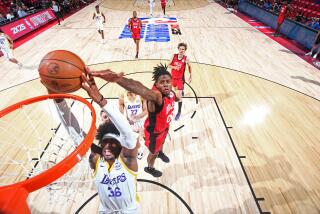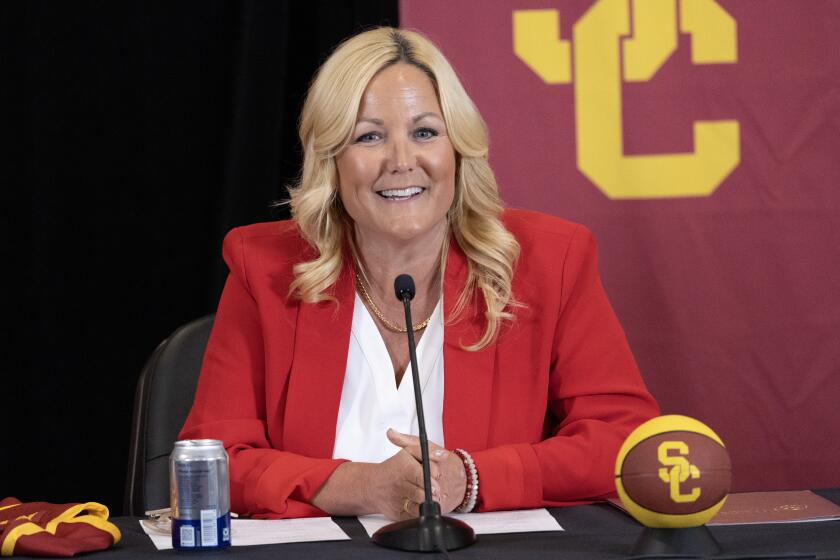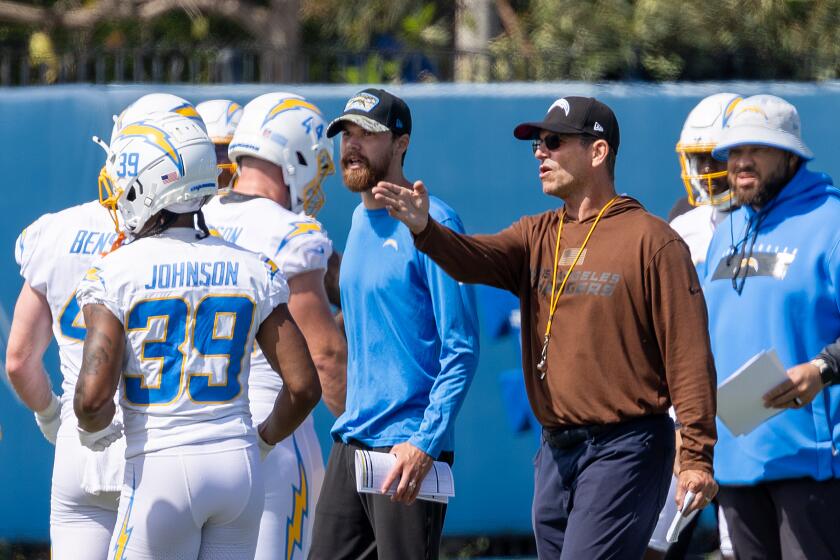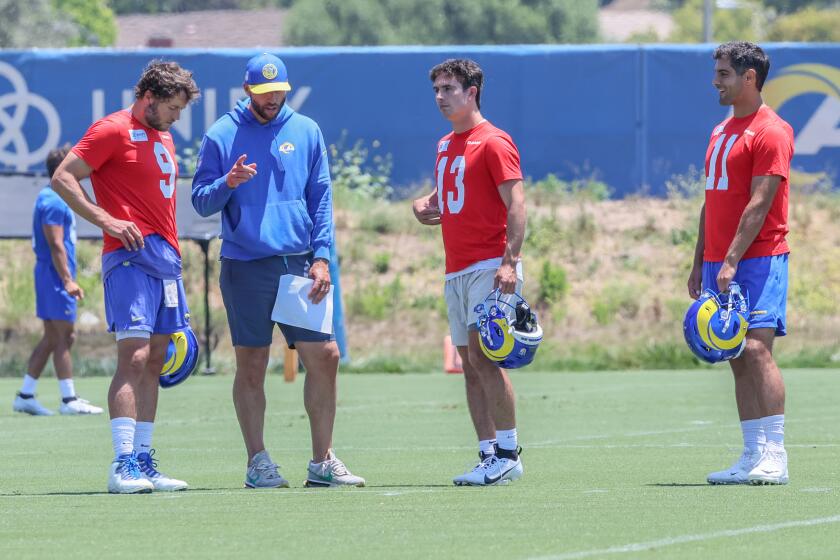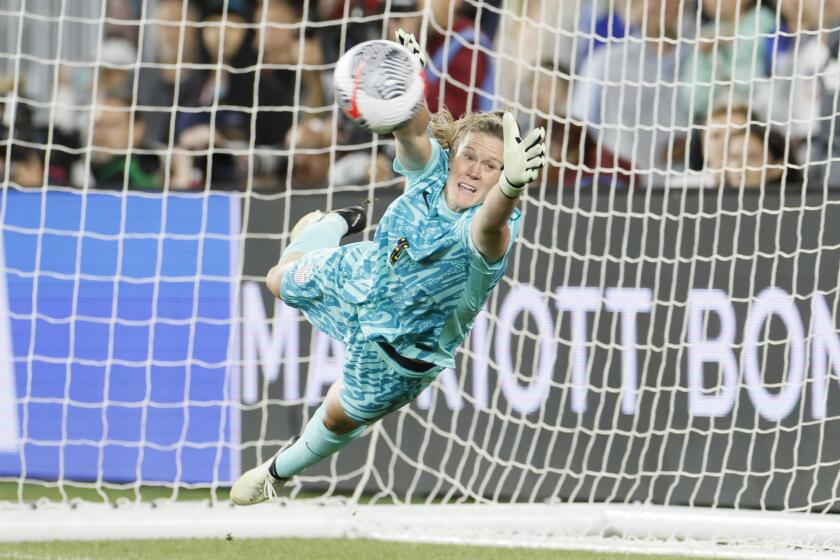Rams Were Beloved in Younger Days
Did you know that, in 1957, the Los Angeles Rams and the San Francisco 49ers played before a paid crowd of 102,368 at the Coliseum?
Did you know that the next year, the Rams and Chicago Bears drew 100,470? Or that one week later they drew 95,082 to a 49er game and, three weeks after that, drew 100,202 to a game with the Baltimore Colts? And that a year earlier, they had drawn more than 100,000 to an exhibition game at the Rose Bowl?
Paul (Tank) Younger could have told you. He was a big part of the early lore of the Rams in La-la Land.
“Being a Ram in those days was like being governor,” Tank says. “Or a movie star.”
As Dickens once said, it was the best of times--and the worst of times. It was best because the Rams drew 100,000 at $5 a head. It was the worst because Tank Younger, whose exploits helped fill those seats, drew $6,000 a year in salary.
“There were no agents in those days,” Tank recalls. “If you showed up with an agent, you were both shown the door.”
Tank was the first NFL player drafted from Grambling State College--now, University--in Louisiana, an institution that was to become nearly as prolific an incubator of pro talent as Notre Dame.
Tank broke new ground for his alma mater, and helped do the same for the Rams. He was not their first black player--Woody Strode and Kenny Washington preceded him--but he was one of the first.
“There were four black players at camp for the Rams my first year,” he recalls, adding, “Know how many there were last year? Sixty-two!”
Tank was a two-way player in those days--linebacker and fullback. He became part of the team’s famed “bull elephant” backfield consisting of Tank, Deacon Dan Towler and Dick Hoerner. (As distinguished from the “pony” backfield of Vitamin Smith, Tommy Kalmanir and Glenn Davis.)
Tank was 6 feet 4, a 235-pounder whose nickname derived from the way he poured through lines--like German armor going through the Low Countries. He scored 60 touchdowns in college--25 as a freshman alone. He beat the college’s Olympic sprinter one day in a 100-yard match race, running in football shoes.
On the Rams, Tank made five consecutive Pro Bowl teams. He had seven 100-yard games. He led the team in rushing in 1954 with a 6.7-yard average, scored eight touchdowns and had one run of 75 yards.
“I toted up once that I had played in 1,050 consecutive plays, and I went in to [owner] Dan Reeves and reminded him. He gave me a raise--all the way to $10,000!”
Still, it was heady stuff.
“The Rams owned the town in those years,” Tank recalls. “It was before the Dodgers, the Lakers, the Kings. Before Disneyland. The Angels were minor league. I remember one game, the fire department shut off sales, and 12,000 were outside trying to get in!”
What happened? Why are the Rams only a memory? Why is the capital of football 400 miles to the north? Who goofed? Why is L.A. without football when there are 10 million more people here than there were in the salad days?
There is enough blame to go round, Tank says. But it saddens him. Makes him indignant.
“I feel as if part of me is gone,” he says. “It’s obscene for L.A. to be without pro football. We put the National in National Football League. We did more for pro football than anyone up to that time.”
For football to leave Los Angeles marooned? He regards that as a sports calamity.
Actually, the Rams left in 1980. They went only 36 miles to the southeast. Even that was a mistake.
Now, they’re headed back across the Great Divide. Reversing all the old Horace Greeley slogans. It’s now, “Go East, young man!” or “Eastward the course of empire takes its way.”
The Rams had left Cleveland in 1945 after seasons in which their presence was such a closely guarded secret that a “crowd” of 4,029 showed up for a game against the Detroit Lions. The Cleveland Rams were desperate to go over the wall. They were ready to take any direction out, including straight up.
There proved to be a special bonding between the Rams and L.A. The team first had to survive a struggle for the affections of the fans with the L.A. Dons of the old All-America Conference. When that was done, the town was theirs.
The myth has grown that, to be a major city, you need a major sports team. Why? Does Paris need the Green Bay Packers? Should Rome have the Mets? Poor Athens has to make do with the Acropolis, does it? Disneyland wasn’t enough for Anaheim?
Did L.A. need the Rams? Or did the Rams need L.A.?
When an owner stencils a community identity on the uniform of his players or his office stationery, he draws on the emotional attachment he derives from that community. He relies on it.
But that, apparently, is no longer enough. Now, the community must not only support him, it must subsidize him. It is his view that the community must build him a state-of-the-art $200-million edifice to play in--complete with luxury boxes--or he will take his ball and his team elsewhere.
No one has ever quite figured out why communities respond to this blackmail. I mean, do we buy property for Texaco to drill for oil? Do we build factories for Toyota? All we gave the movie industry was unlimited access to our sunlight. The taxpayers didn’t have to build their sound stages. Even though movie studios may do far more for tourism than, say, the Clippers.
The Rams were once as much a part of L.A. as Sunset Boulevard, Tank Younger remembers. The Raiders were just tenants, a kind of complicated mobile home double-parked here for a while.
Tank also recalls when the Rams were grateful to be allowed to play in the L.A. Coliseum. Now, St. Louis is throwing satchels full of money at them for moving.
Tank is glad to have played a part in building that success. Of course, he profited, too. His salary climbed clear up to $16,000 a year.
But Tank also has his mementos. The uniform with the ram horns helmet and the No. 35 on the jersey. And his legs, which tell him when it’s going to rain.
More to Read
Go beyond the scoreboard
Get the latest on L.A.'s teams in the daily Sports Report newsletter.
You may occasionally receive promotional content from the Los Angeles Times.

